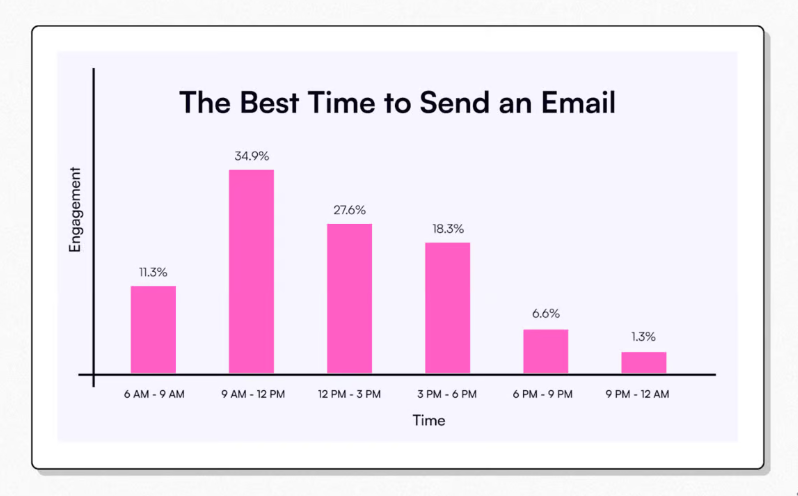The best time to send email marketing depends on your audience. Different times work for different groups.
Email marketing success hinges on timing. Sending at the right moment increases open rates and engagement. Understanding the habits of your audience is key. Are they early birds or night owls? Do they check emails during work or in the evening?
These factors matter. Research shows general trends, but specifics vary. Knowing when your readers are most active helps your message stand out. Dive in to find the best time for your email campaigns.
Optimal Days For Email Marketing
Most effective days for email marketing are Tuesday, Wednesday, and Thursday. These days see higher open rates and engagement. Timing within these days should be around mid-morning or early afternoon.
Weekdays Vs Weekends
Weekdays are often better for email marketing. Most people check their emails during workdays. Tuesday, Wednesday, and Thursday are the best days. Monday is too busy. Friday, people are thinking about the weekend. Weekends are tricky. People are usually off work and may not check emails.
Impact Of Public Holidays
Public holidays can affect email marketing. People are often busy with family or travel. Open rates can be lower. Avoid sending emails on major holidays. The day after a holiday can also be slow. It’s best to wait a day or two.
Best Time Of Day For Sending Emails
Sending emails in the morning can be very effective. People check their inbox early. 7-9 AM is a good time. Many are starting their day. They have fresh minds. They are more likely to read your email.
Emails sent in the afternoon are also good. 1-3 PM works well. People are taking a break. They might check emails. Many are looking for something new. They are more relaxed at this time.
Sending emails in the evening can be tricky. 7-9 PM is best. People are winding down. They might check emails before bed. But they might be tired. Evening sends can be hit or miss.
Audience Segmentation
Different age groups check emails at different times. Young adults often check emails late at night. Older adults might check emails in the morning. Knowing your audience helps pick the right time. Gender can also influence email open rates. Men and women may have different online habits. Understanding these habits can increase your email success.
Time zones affect when people read emails. Send emails at times that match your audience’s local time. In some countries, people check emails more during lunch breaks. In other places, they check emails after work. Holidays and weekends also vary by location. Be aware of these differences for better engagement. Consider regional work hours and customs.
Industry Specific Timing
Sending emails to retail customers works well on weekdays. Tuesday and Thursday mornings get the best results. People often check their emails during these times. Avoid weekends as most people are busy with personal activities.
For B2B emails, mid-week is the best. Wednesday works great. Send your emails early in the morning. People check their work emails first thing. Avoid Mondays as people are catching up from the weekend.
Healthcare professionals are busy. Tuesday and Wednesday mornings are ideal. Avoid late afternoons and evenings. Many healthcare workers are unavailable after their shifts.
Impact Of Time Zones
Sending emails at the right time is crucial. Time zones vary widely across the world. Consider the local time for each recipient. Use tools that help schedule emails based on time zones. This ensures emails arrive during working hours. Higher open rates can be achieved. Avoid sending emails during night hours. People are less likely to open them. Testing different times can help find the best slot. Analyze the results for better strategies.
Focusing on a local audience simplifies timing. Know the peak hours for your audience. Early mornings and late afternoons are often best. People check their emails during these times. Avoid sending emails on weekends. Most people do not check work emails then. Use data to refine your strategy. Look at open rates and adjust timing. Repeat this process for continuous improvement. Engagement will likely increase with better timing.

Credit: coschedule.com
Testing And Analyzing
A/B testing helps find the best time to send emails. Create two groups. Send emails at different times. Compare the results. This method shows what works best. Use small changes for each test. Change only one thing. This gives clear results. Always keep track of the data. Note the open rates and click rates.
Track performance metrics to understand email success. Check open rates. High open rates show good timing. Low rates mean wrong time. Look at click rates too. More clicks mean better engagement. Use this data to improve. Adjust your strategy based on the results. Over time, find the best time for your audience.
Seasonal Considerations
Holiday seasons are busy for everyone. Many people shop online. Emails sent during holidays can get good results. Plan ahead. Send emails before the holiday rush. Christmas, Black Friday, and New Year are key times. Make your email special. Offer deals and discounts.
Business cycles matter too. Some months are better for some businesses. Know your business peaks. Send emails when people are buying. For example, gyms see more sign-ups in January. Retail may do well in the summer. Watch trends. Send emails at the right time.

Credit: www.linkedin.com
Technological Tools
Email automation software can save a lot of time. It sends emails at the right moment. These tools help to schedule emails. They can also send follow-up emails. This keeps your audience engaged. Some software can even personalize emails. This makes your emails feel special. Tools like Mailchimp and SendinBlue are popular. They have many useful features. They are easy to use. Even beginners can use them well.
Analytics tools show how your emails perform. They track open rates and click rates. They can also show the best time to send emails. This helps you make better decisions. Google Analytics and HubSpot are good choices. These tools offer detailed reports. They are very user-friendly. Understanding the data is simple. This makes it easier to improve your email marketing strategy.

Credit: mailshake.com
Frequently Asked Questions
What Is The Best Day To Send Marketing Emails?
The best day to send marketing emails is Tuesday. Research shows higher open and click-through rates on this day.
What Time Should You Send Marketing Emails?
The best time to send marketing emails is between 10 AM and 11 AM. This time shows higher engagement rates.
How Often Should You Send Marketing Emails?
Sending marketing emails once a week is ideal. It keeps your audience engaged without overwhelming them.
Does Email Timing Affect Open Rates?
Yes, email timing significantly affects open rates. Sending emails during peak engagement times increases the likelihood of being opened.
Conclusion
Timing is crucial in email marketing. Send emails during peak engagement hours. Experiment with different times and track results. Consider your audience’s time zones. Test and analyze frequently. Morning and afternoon slots often work best. Remember, each audience is unique.
Adjust strategies based on their behavior. Consistency and attention to detail are key. Happy emailing!










